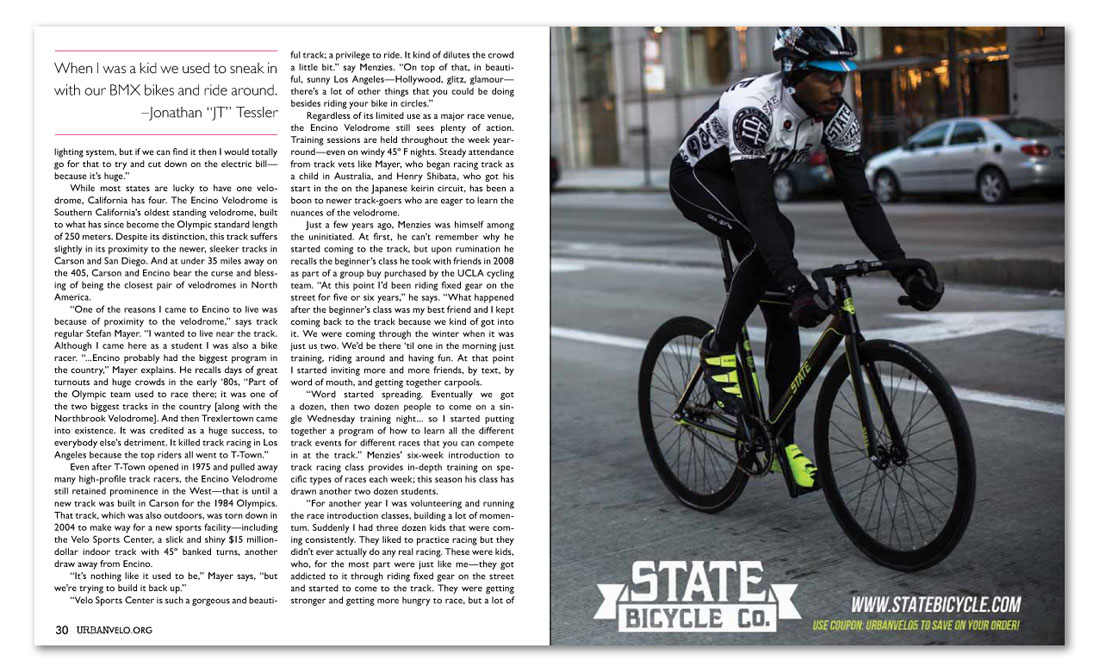


lighting system at the track,” Menzies says. “It’s pretty much a pipe dream. There’s not a huge chance that we’ll raise enough money to install a more efficient lighting system, but if we can find it then I would totally go for that to try and cut down on the electric bill—because it’s huge.”
While most states are lucky to have one velodrome, California has four. The Encino Velodrome is Southern California’s oldest standing velodrome, built to what has since become the Olympic standard length of 250 meters. Despite its distinction, this track suffers slightly in its proximity to the newer, sleeker tracks in Carson and San Diego. And at under 35 miles away on the 405, Carson and Encino bear the curse and blessing of being the closest pair of velodromes in North America.
“One of the reasons I came to Encino to live was because of proximity to the velodrome,” says track regular Stefan Mayer. “I wanted to live near the track. Although I came here as a student I was also a bike racer. “...Encino probably had the biggest program in the country,” Mayer explains. He recalls days of great turnouts and huge crowds in the early ‘80s, “Part of the Olympic team used to race there; it was one of the two biggest tracks in the country [along with the Northbrook Velodrome]. And then Trexlertown came into existence. It was credited as a huge success, to everybody else’s detriment. It killed track racing in Los Angeles because the top riders all went to T-Town.”
Even after T-Town opened in 1975 and pulled away many high-profile track racers, the Encino Velodrome still retained prominence in the West—that is until a new track was built in Carson for the 1984 Olympics. That track, which was also outdoors, was torn down in 2004 to make way for a new sports facility—including the Velo Sports Center, a slick and shiny $15 million-dollar indoor track with 45º banked turns, another draw away from Encino.
“It’s nothing like it used to be,” Mayer says, “but we’re trying to build it back up.”
“Velo Sports Center is such a gorgeous and beautiful track; a privilege to ride. It kind of dilutes the crowd a little bit.” say Menzies. “On top of that, in beautiful, sunny Los Angeles—Hollywood, glitz, glamour—there’s a lot of other things that you could be doing besides riding your bike in circles.”
Regardless of its limited use as a major race venue, the Encino Velodrome still sees plenty of action. Training sessions are held throughout the week year-round—even on windy 45º F nights. Steady attendance from track vets like Mayer, who began racing track as a child in Australia, and Henry Shibata, who got his start in the on the Japanese keirin circuit, has been a boon to newer track-goers who are eager to learn the nuances of the velodrome.
Just a few years ago, Menzies was himself among the uninitiated. At first, he can’t remember why he started coming to the track, but upon rumination he recalls the beginner’s class he took with friends in 2008 as part of a group buy purchased by the UCLA cycling team. “At this point I’d been riding fixed gear on the street for five or six years,” he says. “What happened after the beginner’s class was my best friend and I kept coming back to the track because we kind of got into it. We were coming through the winter when it was just us two. We’d be there ‘til one in the morning just training, riding around and having fun. At that point I started inviting more and more friends, by text, by word of mouth, and getting together carpools.
“Word started spreading. Eventually we got a dozen, then two dozen people to come on a single Wednesday training night... so I started putting together a program of how to learn all the different track events for different races that you can compete in at the track.” Menzies’ six-week introduction to track racing class provides in-depth training on specific types of races each week; this season his class has drawn another two dozen students.
“For another year I was volunteering and running the race introduction classes, building a lot of momentum. Suddenly I had three dozen kids that were coming consistently. They liked to practice racing but they didn’t ever actually do any real racing. These were kids, who, for the most part were just like me—they got addicted to it through riding fixed gear on the street and started to come to the track. They were getting stronger and getting more hungry to race, but a lot of